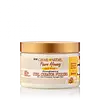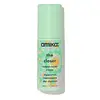What's inside
What's inside
 Key Ingredients
Key Ingredients

No key ingredients
 Benefits
Benefits

 Concerns
Concerns

 Ingredients Side-by-side
Ingredients Side-by-side

Water
Skin ConditioningButyrospermum Parkii Butter
Skin ConditioningGlycerin
HumectantCetearyl Alcohol
EmollientGlyceryl Stearate
EmollientCocos Nucifera Oil
MaskingMangifera Indica Seed Butter
Skin ConditioningCetyl Alcohol
EmollientCetrimonium Chloride
AntimicrobialParfum
MaskingMusa Paradisiaca Fruit Extract
Skin ConditioningPanthenol
Skin ConditioningMel
EmollientKeratin Amino Acids
Skin ConditioningEthylhexyl Methoxycinnamate
UV AbsorberButylene Glycol
HumectantBenzyl Benzoate
AntimicrobialBenzyl Salicylate
PerfumingHexyl Cinnamal
PerfumingHydroxycitronellal
PerfumingLimonene
PerfumingLinalool
PerfumingPhenoxyethanol
PreservativeBenzyl Alcohol
PerfumingCI 19140
Cosmetic ColorantCI 15985
Cosmetic ColorantWater, Butyrospermum Parkii Butter, Glycerin, Cetearyl Alcohol, Glyceryl Stearate, Cocos Nucifera Oil, Mangifera Indica Seed Butter, Cetyl Alcohol, Cetrimonium Chloride, Parfum, Musa Paradisiaca Fruit Extract, Panthenol, Mel, Keratin Amino Acids, Ethylhexyl Methoxycinnamate, Butylene Glycol, Benzyl Benzoate, Benzyl Salicylate, Hexyl Cinnamal, Hydroxycitronellal, Limonene, Linalool, Phenoxyethanol, Benzyl Alcohol, CI 19140, CI 15985
Water
Skin ConditioningAloe Barbadensis Leaf Juice
Skin ConditioningDimethicone
EmollientIsopropyl Palmitate
EmollientGlyceryl Stearate Se
EmulsifyingGlycerin
HumectantCetearyl Alcohol
EmollientCetearyl Glucoside
EmulsifyingPolyquaternium-55
Hippophae Rhamnoides Fruit/Seed Oil
AntimicrobialBorago Officinalis Seed Oil
EmollientMangifera Indica Seed Butter
Skin ConditioningButyrospermum Parkii Butter
Skin ConditioningGuar Hydroxypropyltrimonium Chloride
Skin ConditioningGalactoarabinan
Camellia Sinensis Leaf Extract
AntimicrobialLavandula Angustifolia Flower Extract
CleansingPanthenol
Skin ConditioningHydrolyzed Quinoa
Skin ConditioningHydrolyzed Rice Protein
Skin ConditioningHydrolyzed Adansonia Digitata Seed Extract
Hydrolyzed Vegetable Protein
Skin ConditioningCoco-Caprylate/Caprate
EmollientCoconut Alkanes
EmollientOlealkonium Chloride
Cinnamidopropyltrimonium Chloride
Polyquaternium-11
Coceth-7
EmulsifyingButylene Glycol
HumectantAcrylamidopropyltrimonium Chloride/Acrylates Copolymer
Bis-PCA Dimethicone
Disodium PEG-12 Dimethicone Sulfosuccinate
CleansingIsohexadecane
EmollientAminomethyl Propanol
BufferingCaprylyl Glycol
EmollientSorbitan Isostearate
EmulsifyingPotassium Sorbate
PreservativeSodium Benzoate
MaskingCitric Acid
BufferingBenzyl Alcohol
PerfumingAlcohol
AntimicrobialPhenoxyethanol
PreservativeParfum
MaskingBenzyl Benzoate
AntimicrobialHydroxycitronellal
PerfumingLimonene
PerfumingCitronellol
PerfumingCoumarin
PerfumingWater, Aloe Barbadensis Leaf Juice, Dimethicone, Isopropyl Palmitate, Glyceryl Stearate Se, Glycerin, Cetearyl Alcohol, Cetearyl Glucoside, Polyquaternium-55, Hippophae Rhamnoides Fruit/Seed Oil, Borago Officinalis Seed Oil, Mangifera Indica Seed Butter, Butyrospermum Parkii Butter, Guar Hydroxypropyltrimonium Chloride, Galactoarabinan, Camellia Sinensis Leaf Extract, Lavandula Angustifolia Flower Extract, Panthenol, Hydrolyzed Quinoa, Hydrolyzed Rice Protein, Hydrolyzed Adansonia Digitata Seed Extract, Hydrolyzed Vegetable Protein, Coco-Caprylate/Caprate, Coconut Alkanes, Olealkonium Chloride, Cinnamidopropyltrimonium Chloride, Polyquaternium-11, Coceth-7, Butylene Glycol, Acrylamidopropyltrimonium Chloride/Acrylates Copolymer, Bis-PCA Dimethicone, Disodium PEG-12 Dimethicone Sulfosuccinate, Isohexadecane, Aminomethyl Propanol, Caprylyl Glycol, Sorbitan Isostearate, Potassium Sorbate, Sodium Benzoate, Citric Acid, Benzyl Alcohol, Alcohol, Phenoxyethanol, Parfum, Benzyl Benzoate, Hydroxycitronellal, Limonene, Citronellol, Coumarin
Ingredients Explained
These ingredients are found in both products.
Ingredients higher up in an ingredient list are typically present in a larger amount.
Benzyl Alcohol is most commonly used as a preservative. It also has a subtle, sweet smell. Small amounts of Benzyl Alcohol is not irritating and safe to use in skincare products. Most Benzyl Alcohol is derived from fruits such as apricots.
Benzyl Alcohol has both antibacterial and antioxidant properties. These properties help lengthen the shelf life of products. Benzyl Alcohol is a solvent and helps dissolve other ingredients. It can also improve the texture and spreadability.
Alcohol comes in many different forms. Different types of alcohol will have different effects on skin. This ingredient is an astringent alcohol.
Using high concentrations of these alcohols are drying on the skin. They may strip away your skin's natural oils and even damage your skin barrier. Astringent alcohols may also irritate skin.
Other types of astringent alcohols include:
According to the National Rosacea Society based in the US, you should be mindful of products with these alcohols in the top half of ingredients.
Any type of sanitizing product will have high amounts of alcohol to help kill bacteria and viruses.
Learn more about Benzyl AlcoholBenzyl Benzoate is usually created from the condensation of benzoic acid and benzyl alcohol. It is used as a preservative, solvent, and has a floral/balsamic scent in large amounts.
As a preservative, Benzyl Benzoate works against bacteria and fungus. It is often used to treat scabies and lice in medicine.
Solvents are used to keep ingredients together in a product. They can help dissolve ingredients to stable bases or help evenly distribute ingredients throughout the product.
Due to its fragrance, Benzyl Benzoate can be sensitizing and may cause contact dermatitis. It is a known EU allergen. We recommend speaking with a professional if you have any concerns.
Benzyl Benzoate can be naturally found in cranberries and peaches.
Learn more about Benzyl BenzoateButylene Glycol (or BG) is used within cosmetic products for a few different reasons:
Overall, Butylene Glycol is a safe and well-rounded ingredient that works well with other ingredients.
Though this ingredient works well with most skin types, some people with sensitive skin may experience a reaction such as allergic rashes, closed comedones, or itchiness.
Learn more about Butylene GlycolThis ingredient is also known as shea butter. It is an effective skin hydrator and emollient.
Emollients help soothe and soften your skin. It does this by creating a protective film on your skin. This barrier helps trap moisture and keeps your skin hydrated. Emollients may be effective at treating dry or itchy skin.
Shea butter is rich in antioxidants. Antioxidants help fight free-radicals, or molecules that may harm the body. It is also full of fatty acids including stearic acid and linoleic acid. These acids help replenish the skin and keep skin moisturized.
While Shea Butter has an SPF rating of about 3-4, it is not a sunscreen replacement.
Shea butter may not be fungal acne safe. We recommend speaking with a professional if you have any concerns.
Learn more about Butyrospermum Parkii ButterCetearyl alcohol is a mixture of two fatty alcohols: cetyl alcohol and stearyl alcohol. It is mainly used as an emulsifier. Emulsifiers help prevent the separation of oils and products. Due to its composition, it can also be used to thicken a product or help create foam.
Cetearyl alcohol is an emollient. Emollients help soothe and hydrate the skin by trapping moisture.
Studies show Cetearyl alcohol is non-toxic and non-irritating. The FDA allows products labeled "alcohol-free" to have fatty alcohols.
This ingredient is usually derived from plant oils such as palm, vegetable, or coconut oils. There is debate on whether this ingredient will cause acne.
Due to the fatty acid base, this ingredient may not be Malassezia folliculitis safe.
Learn more about Cetearyl AlcoholGlycerin is already naturally found in your skin. It helps moisturize and protect your skin.
A study from 2016 found glycerin to be more effective as a humectant than AHAs and hyaluronic acid.
As a humectant, it helps the skin stay hydrated by pulling moisture to your skin. The low molecular weight of glycerin allows it to pull moisture into the deeper layers of your skin.
Hydrated skin improves your skin barrier; Your skin barrier helps protect against irritants and bacteria.
Glycerin has also been found to have antimicrobial and antiviral properties. Due to these properties, glycerin is often used in wound and burn treatments.
In cosmetics, glycerin is usually derived from plants such as soybean or palm. However, it can also be sourced from animals, such as tallow or animal fat.
This ingredient is organic, colorless, odorless, and non-toxic.
Glycerin is the name for this ingredient in American English. British English uses Glycerol/Glycerine.
Learn more about GlycerinHydroxycitronellal is a fragrance created from citronellal. The smell of hydroxycitronellal is often described as "citrus-like" or "melon-like".
Hydroxycitronellal is a known EU allergen and may cause irritation when applied to the skin.
Limonene is a fragrance that adds scent and taste to a formulation.
It's found in the peel oil of citrus fruits and other plants such as lavender and eucalyptus. The scent of limonene is generally described as "sweet citrus".
Limonene acts as an antioxidant, meaning it helps neutralize free radicals.
When exposed to air, oxidized limonene may sensitize the skin. Because of this, limonene is often avoided by people with sensitive skin.
The term 'fragrance' is not regulated in many countries. In many cases, it is up to the brand to define this term. For instance, many brands choose to label themselves as "fragrance-free" because they are not using synthetic fragrances. However, their products may still contain ingredients such as essential oils that are considered a fragrance.
Learn more about LimoneneMangifera Indica Seed Butter isn't fungal acne safe.
Panthenol is a common ingredient that helps hydrate and soothe the skin. It is found naturally in our skin and hair.
There are two forms of panthenol: D and L.
D-panthenol is also known as dexpanthenol. Most cosmetics use dexpanthenol or a mixture of D and L-panthenol.
Panthenol is famous due to its ability to go deeper into the skin's layers. Using this ingredient has numerous pros (and no cons):
Like hyaluronic acid, panthenol is a humectant. Humectants are able to bind and hold large amounts of water to keep skin hydrated.
This ingredient works well for wound healing. It works by increasing tissue in the wound and helps close open wounds.
Once oxidized, panthenol converts to pantothenic acid. Panthothenic acid is found in all living cells.
This ingredient is also referred to as pro-vitamin B5.
Learn more about PanthenolParfum is a catch-all term for an ingredient or more that is used to give a scent to products.
Also called "fragrance", this ingredient can be a blend of hundreds of chemicals or plant oils. This means every product with "fragrance" or "parfum" in the ingredients list is a different mixture.
For instance, Habanolide is a proprietary trade name for a specific aroma chemical. When used as a fragrance ingredient in cosmetics, most aroma chemicals fall under the broad labeling category of “FRAGRANCE” or “PARFUM” according to EU and US regulations.
The term 'parfum' or 'fragrance' is not regulated in many countries. In many cases, it is up to the brand to define this term.
For instance, many brands choose to label themselves as "fragrance-free" because they are not using synthetic fragrances. However, their products may still contain ingredients such as essential oils that are considered a fragrance by INCI standards.
One example is Calendula flower extract. Calendula is an essential oil that still imparts a scent or 'fragrance'.
Depending on the blend, the ingredients in the mixture can cause allergies and sensitivities on the skin. Some ingredients that are known EU allergens include linalool and citronellol.
Parfum can also be used to mask or cover an unpleasant scent.
The bottom line is: not all fragrances/parfum/ingredients are created equally. If you are worried about fragrances, we recommend taking a closer look at an ingredient. And of course, we always recommend speaking with a professional.
Learn more about ParfumPhenoxyethanol is a preservative that has germicide, antimicrobial, and aromatic properties. Studies show that phenoxyethanol can prevent microbial growth. By itself, it has a scent that is similar to that of a rose.
It's often used in formulations along with Caprylyl Glycol to preserve the shelf life of products.
Water. It's the most common cosmetic ingredient of all. You'll usually see it at the top of ingredient lists, meaning that it makes up the largest part of the product.
So why is it so popular? Water most often acts as a solvent - this means that it helps dissolve other ingredients into the formulation.
You'll also recognize water as that liquid we all need to stay alive. If you see this, drink a glass of water. Stay hydrated!
Learn more about Water